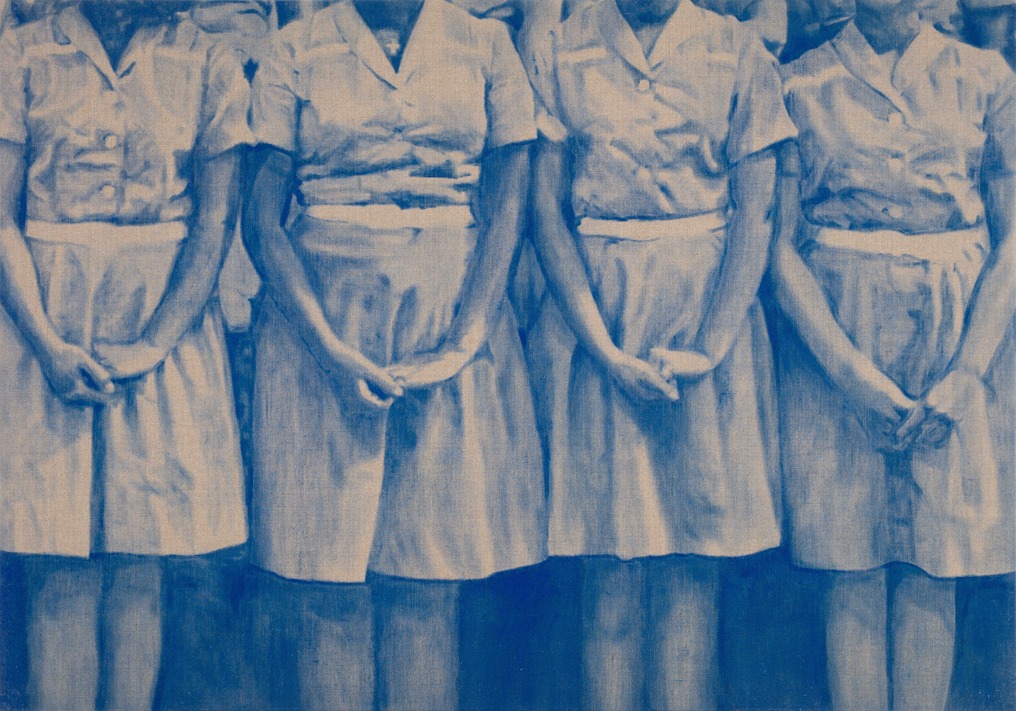Marsi van de Heuvel – Identity and an archive of Representation

With her paintings Van de Heuvel strives for visibility and comments on the value of representation.
Through her fragile painted compositions, Marsi van de Heuvel’s practice works with familial history reflecting back on the history of South Africa. Her work relates to themes of place and the difficulty connected to a communal sense of belonging. Her latest body of work ‘Movie Snaps’ sees Van de Heuvel reconnecting with her deep rooted interest in photographic archives making use of street photographs produced by the Movie Snaps Studio in Cape Town from the 1930s to the 1980s.
In a building found on the edge of the Grand Parade, The Movie Snaps Studio set up shop during the start of the Second World War. These photographic representations shone a light on ordinary moments, offering a point of contestation to the warped and violent narratives conjured about non-white persons.
There is a beauty and arresting nostalgia connected to Movie Snaps photographs which can be seen in the mere fact that many of these originals still adorn the walls and homes of the descendants of these photographic snaps. A moment can last more than a life time.
The subjects of the Movie Snaps photographs are often found wearing their “Sunday best.” By purchasing these images after the fact, they show self-love and this acts as an affirmation of the city’s multiculturalism outside of the harrowing circumstances of apartheid experienced by the vast majority of citizens.
Raw linen and white oil paint result in a fragile composition commenting on the way in which both photographic prints and our memories become vague with the passing of time. Negative space abounds in Van de Heuvel’s paintings creating room for her viewer to symbolically take up space with their personal impressions of what has been left out of her compositions.
Van de Heuvel expresses, “Movie Snaps is a form of collective recorded history. It is an archive. I want it to feel like the paintings are about giving light, care, honour and celebration to these people who walked here before us.”
“Movie Snaps is a form of collective recorded history. It is an archive. I want it to feel like the paintings are about giving light, care, honour and celebration to these people who walked here before us.”
‘Skoonveld’ is another series by Van de Heuvel that can be directly translated to mean “clean field” and can be used as a means of expressing that something is completely gone. This sentiment echoes the emptiness of forced removals and land appropriation associated with the apartheid regime. This can similarly be related to the systematic erasure of the culture and history of “coloured” people as labelled by the apartheid government and described only in negative ways. Marsi’s work addresses this historical erasure.
Whilst grappling with her own identity, Marsi discovered a biscuit tin that held her grandmother’s photographs, acting as a record of her family’s life living in Umtata, Upington and Graff Reinet. Working with notions of belonging to place, culture and family, the artist re-imagines these photographs taken by her maternal grandmother and other family members throughout apartheid. In an act of artistic expression she breaks down and reconstructs the familial archive and carefully re-remembers and re-imagines the experiences of those who came before her. Her act examines her heritage which has become hazy through racial classification, forced removals and indignity.
Oils and other media are employed as the tools for destabilising negative views imposed upon people of colour through slavery and apartheid. Van de Heuvel zooms in on smaller details like handbags and gloved hands, a subtle hint to a special occasion. This is similarly a representation of the respectability that mothers and grandmothers aimed to express as an antithesis to racist rhetoric.
‘Skoonveld’ sees a multitude of references made to the classroom, a space ferociously policed by apartheid. Through her painting practice, Marsi recreates a stereotypical class portrait reflecting the Eurocentric standards that people of colour had to face daily. These images are projected on a chalkboard acting as a commentary on impermanence and fragility.
By merging painting and documentary photography, the artist invites the viewer to recognise themselves, their own families and the legacy of identity.




